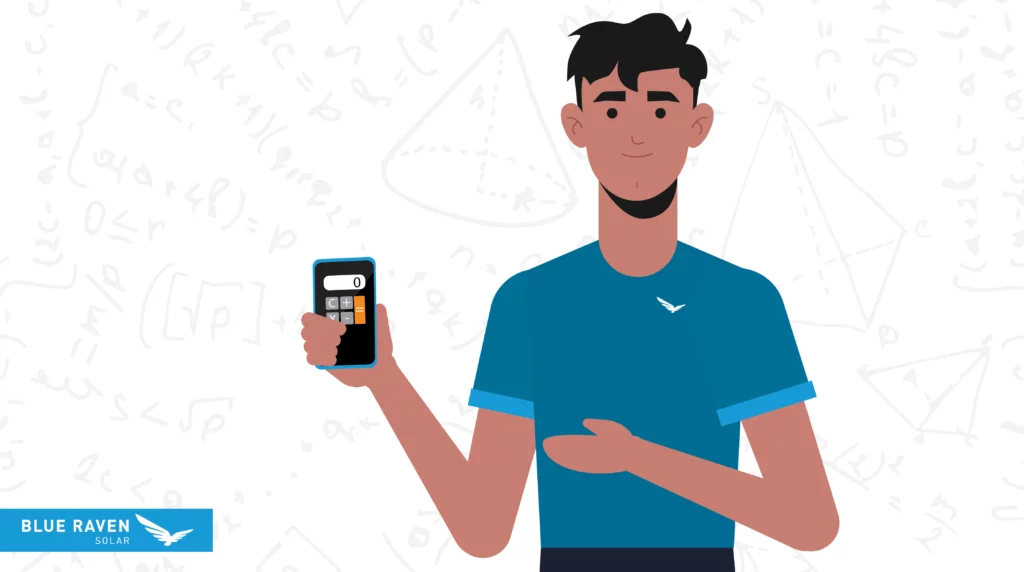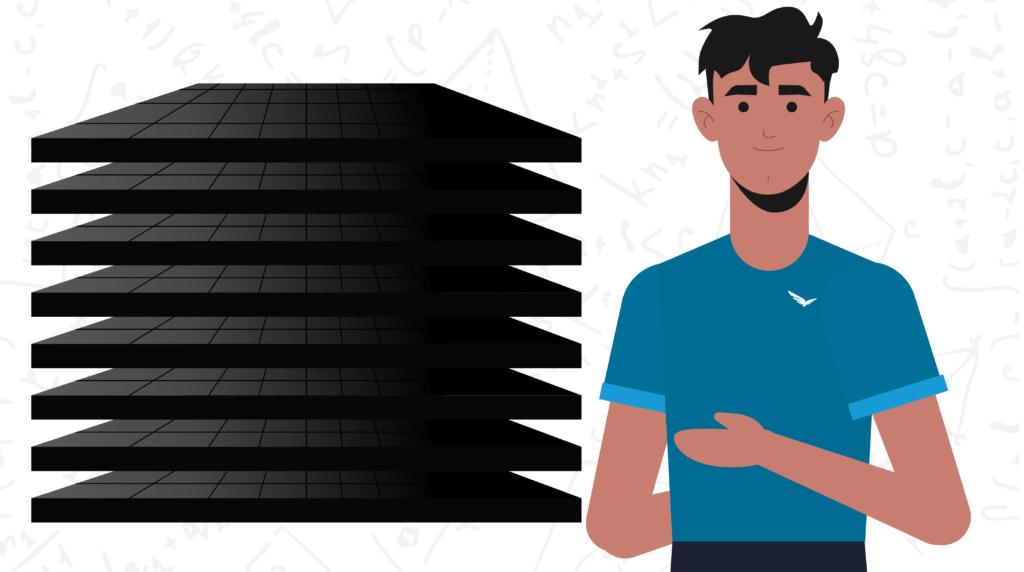
Solar panels are made in a uniform shape, but there is no uniform formula for designing a solar array. In fact, it should be a red flag if a solar company offers you a price point without asking specific questions first. Because every home is different, every state has different weather patterns, and every family has a unique set of specific needs. Installing solar panels to reliably meet your needs throughout the year calls for a custom design.
If we are talking about estimating the cost of home solar systems, the one statement we can make is solar cost is a function of system size.
Size depends on multiple factors:
- Average Energy Usage
- Panel Direction
- Watts Per Panel
- Panel Angle and Layout
- Roof Shading
- Weather Patterns and Climates
Your Energy Usage
The first factor we consider in every custom design proposal we create is how much energy you consume.
At Blue Raven Solar, we start the design estimate conversation by reviewing your utility bills, beginning with your most recent and going back from six months to a year. We understand your bills will fluctuate throughout the year due to seasonal changes. The more information we can assemble about your household energy consumption the easier it is for us to accurately estimate the size of the solar panel array you will need.
Then, we look at a few other factors to determine panel placement and quantity.

Calculating Optimum Production
For optimal production, we design the system to produce enough energy to offset your monthly costs with as few panels as possible. To find the ideal number of solar panels, we must first consider:
Panel Direction
Facing straight toward the sun is ideal, but not required. In North America, mounting solar panels facing south—or as close to it as possible—is the optimal direction. Southern exposure gives the panels the most time in the sun. On some homes it is only possible to mount panels more east or west facing, both directions also work but it could contribute to an increased number of panels needed.
Watts Per Panel
Our 400-watt panels are theoretically capable of generating 400 watts/hour at peak efficiency. As an example, let’s assume a direct-facing solar system of 24 panels generates 9,600 watts per hour of peak sunlight. The panels Blue Raven Solar installs can produce energy with direct and indirect sunlight, which also means they can produce ample energy even when the sky is cloudy.

Panel Angle and Layout
Tilted at 45 degrees is ideal. Since solar panels get mounted directly to the roof, the pitch of the roof becomes the tilt angle of the panels. Solar panels work best at a 12/12 pitch—which is, 12 inches of rise and 12 inches of run per linear foot (45 degrees). Homes with this pitch are not common. There are complex calculations for this, and they vary greatly in the US; so, whether you are in Portland, Oregon or Raleigh, North Carolina matters greatly to your solar system design.
Roof Shading
Having a house surrounded by trees shading your roof does not disqualify you from getting solar but may force you into a decision. In a lot of cases, roofs heavily shaded by surrounding trees can still go solar and produce the right amount of energy, it may take more solar panels to do it. Sometimes homeowners accept the solar panel installation cost increase. Other times they elect to trim the trees back or even cut them down. It just depends on what is more important to each homeowner.
Solar Easement Laws
Once your system is installed, there are also legal protections in some states known as solar easements. These are agreements between you and surrounding landowners state you own the rights to the solar rays powering your system. If a property owner plants trees, or a contracting company builds a high-rise blocking your sunlight, there are ways to make up for the sudden loss to your savings.
Weather Patterns and Climates
A mild yet sunny climate can also be helpful. Since solar panels produce energy most efficiently when they are not too hot, the ideal climate is both sunny and mild. Some states with ideal solar climates include Arizona, Nevada, and North Carolina. Since there are not many places with dominant weather patterns, we look for the best way to strike a balance with the specific climate conditions in each location.
It might also be easy to assume solar is not going to work effectively if you live in a particularly snowy climate, but this perception is false. Solar panels generate heat while they produce energy, and they can easily melt snow off that might obstruct them from receiving solar rays. Because of their durable design, solar panels can easily survive the impact of hailstones as well.

Average Costs
The costs of solar is determined by the size of your solar system as well as how you go about installing it. There are many ways a solar system can save you money outside of a lower electric bill.
Nationally, the average output of rooftop solar arrays we install is 6kW. The output is another factor of size. We install solar panels with a maximum output of 405W per panel. Therefore, a 6kW system would equal about 14-15 panels. The panels we install measure approximately 65″ X 39″ or about 16.5 square feet, so about 230 square feet of available rooftop space is what we need.
Owning is Better Than Leasing
If you are looking to own your solar energy system—which is what we recommend—as opposed to leasing one, then you are paying for the hardware and the cost of labor to install it. What most homeowners do not realize is owning a rooftop solar array does not require a lot of cash up front. In fact, our solar award-winning financing option, BluePower Plus+ calls for $0 down.
Owning your solar array means you pocket the tax benefits, the monthly energy savings, and the net metering energy credits. Additionally, you can receive the state, city, or utility company cash rebates, which all tend to be lucrative. Owning your solar array increases your home equity in an amount roughly equal to your annual energy savings multiplied by 20.
Solar companies who encourage Power Purchase Agreements (PPAs) or leasing agreements cut you off from these benefits, rebates, and savings. With PPAs, they install the system for a price and then sell you power at their rate instead of the power company. With leasing agreements, you pay to rent equipment bolted onto your home. In both situations, they get the tax benefits, and you continue to pay their rates for energy being produced.

Having a Loan Payment Instead of a Utility Bill is Better
We find most of our customers care about having favorable monthly payments than minimizing the overall cost of solar. Solar financing pays dividends over time. Utility bills can fluctuate from one month to the next, but energy prices everywhere trend upward from one year to the next, rising at least 1% each year, if not more.
With a solar loan, you end up with a low and fixed monthly bill for the life of the loan. At Blue Raven Solar, your monthly bill for the installation will be lower than your average power bill from before. Plus, once the loan is paid off, you get the benefit of producing clean energy for free from that day forward with only a small monthly connection fee to your local utility grid.
Tax Incentives Can Help You Pay Off Your Loan Faster
Right now, the federal government lets you deduct 30% of the cost of installing a rooftop solar-electric generator from your federal income taxes. You can include the cost of any necessary remodeling or retrofitting work associated with the solar panel installation from your federal income taxes, made possible through the Federal Solar Investment Tax Credit (ITC).
Renewable Portfolio Standards allow some states to offer their own income tax credit, and many states also exempt solar owners from sales tax on solar equipment and an increase of property taxes, even though solar panels increase the home value!
It is also common for utility companies to provide additional cash incentives. If you decide to go solar with Blue Raven Solar, we handle the red tape and paperwork on all the tax benefits and cash rebates and apply them directly to your solar loan, so you walk away with lower monthly payments and an earlier payoff date.
Do Not Settle for Average Cost, Get a Blue Raven Solar Proposal
We check in with our customers after one year to audit the production of their solar array, and then again two years post-installation. If our solar energy systems are found to produce less than 50% of the original estimates over any three-month period or less than 85% of original estimates over an 18-month period, we will upgrade the system by adding more panels free of charge. Combine this production guarantee with our 25-year manufacturer warranty, and your solar system is built to last.
Estimating the cost of a solar system has many factors to consider, but at Blue Raven Solar, we make it easy.
Contact us today if you have questions or want to request an estimate. Our solar experts will reach out so you can get started on owning your own solar system, owning your own electricity, and owning your energy future.

Blue Raven Solar Cutomizes Your Proposal
While most construction contractors can create ballpark estimates based on a general pricing model like cost per square foot, with solar there is too much variation to do it accurately. All it takes to get started is an evaluation of your average monthly energy consumption and the structure of your house.
After submitting both to Blue Raven Solar, we consult with you about how much you can expect to pay each month and what financing options are available. Going solar is easy with no upfront costs. Our systems come with a production guarantee in case the original estimate misses the mark.
We are here to be a solar partner you can rely on and trust. If you request an estimate with us, we will look over your details, and help you determine if renewable energy is the next step. We want you to own your solar system and we want it to work for you.



Sorry, the comment form is closed at this time.